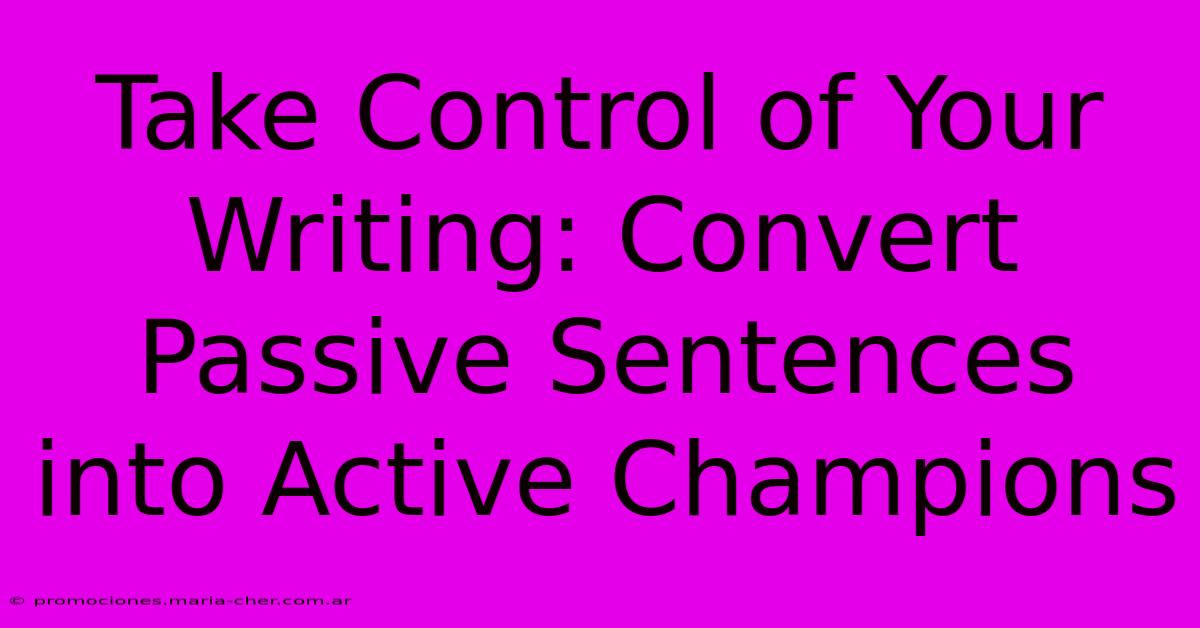Take Control Of Your Writing: Convert Passive Sentences Into Active Champions

Table of Contents
Take Control of Your Writing: Convert Passive Sentences into Active Champions
Passive voice. It’s the grammatical gremlin that haunts writers, sucking the energy from their prose and leaving readers feeling… well, passive. But fear not! This comprehensive guide will equip you with the tools to slay this stylistic beast and transform your writing into a powerful, active force. We'll explore what passive voice is, why it's often problematic, and most importantly, how to convert those passive sentences into dynamic active champions.
Understanding the Passive Voice Problem
Before we dive into solutions, let's define the enemy. A passive sentence follows a structure where the subject receives the action rather than performing it. The key culprits are forms of the verb "to be" (is, are, was, were, been, being) combined with a past participle.
Example of Passive Voice: The ball was thrown by the boy.
Notice how the ball (the subject) is acted upon. The real actor, the boy, is relegated to a prepositional phrase.
Why is Passive Voice Often Problematic?
- Weak and Vague: Passive voice often obscures the actor, creating ambiguity and a sense of distance. Who exactly threw the ball? In some contexts, this vagueness is acceptable, but often it weakens your writing.
- Wordy and Inefficient: Passive constructions tend to be longer and less direct than their active counterparts. This can make your writing cumbersome and difficult to read.
- Less Engaging: Active voice is more dynamic and engaging for the reader. It creates a stronger connection between the subject and the action, making your writing more impactful.
Transforming Passive Sentences into Active Powerhouses
The good news is that transforming passive sentences is a manageable process. Here's a step-by-step guide:
1. Identify the Passive Construction:
First, pinpoint the verb phrase. Does it contain a form of "to be" followed by a past participle? If so, you likely have a passive sentence.
2. Find the Actor:
Who or what is actually performing the action? This information is often buried in a prepositional phrase (usually starting with "by").
3. Re-structure the Sentence:
Make the actor the subject of the sentence, and change the verb to its active form.
Let's transform our example:
- Passive: The ball was thrown by the boy.
- Active: The boy threw the ball.
See how much more concise and impactful the active sentence is?
More Complex Passive Sentence Transformations
Some passive sentences are more intricate. Here are some advanced techniques:
Dealing with "being" verbs: Sentences using "is being," "was being," etc., require more careful restructuring. Focus on identifying the true subject and action.
Passive with "get" + past participle: Phrases like "The window got broken" can be transformed similarly to other passive sentences.
Sentences without a clearly stated actor: If the actor is unknown or irrelevant, consider alternative phrasing to avoid vagueness. Instead of "Mistakes were made," try "Several errors occurred" or "The process encountered difficulties."
Mastering Active Voice for Stronger Writing
By consistently identifying and converting passive sentences into their active counterparts, you will significantly improve the clarity, conciseness, and overall impact of your writing. This will not only make your writing more engaging for your readers but will also demonstrate your writing prowess. Practice makes perfect! Start reviewing your own writing, paying close attention to verb structures. You'll soon become adept at identifying and conquering passive voice, leaving only strong, active sentences in your wake.
Keywords: Passive voice, active voice, writing style, grammar, sentence structure, improve writing, clear writing, concise writing, stronger writing, editing, proofreading, writing tips, writing skills.

Thank you for visiting our website wich cover about Take Control Of Your Writing: Convert Passive Sentences Into Active Champions. We hope the information provided has been useful to you. Feel free to contact us if you have any questions or need further assistance. See you next time and dont miss to bookmark.
Featured Posts
-
Mastering The Art Of Filets And Fillets A Seafood Chefs Secrets
Feb 09, 2025
-
Unraveling The Hidden Truths The Mystery Of Artefacts Vs Artifacts Revealed
Feb 09, 2025
-
Unveiled The Essential Guide To Mastering Formal English Translation
Feb 09, 2025
-
The Ultimate Guide Distinguishing Artefacts And Artifacts For The Confused
Feb 09, 2025
-
Dammed Or Damned The Chilling Connection Between Water And Fate
Feb 09, 2025
